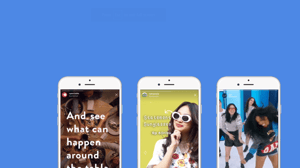
Facebook Launches Ads for Stories: The Rise of the Story Format
Once upon a time, Snapchat was seen as a niche Millennial social networking platform.
Those days are long gone. As Snapchat's user base grew, established platforms like Facebook and Instagram began to sit up and take notice. When Facebook bought over Instagram and launched Stories in 2016, people began to take this new vertical, often-unfiltered picture / video content format more seriously. Fast forward to March 2017 - when Facebook announced its own native Stories, it moved the format from something new and experimental to a mainstay.
These days, even your parents or grandparents on Facebook are sharing Facebook Stories. This year, Instagram announced that Stories had surpassed the number of feed posts shared and is growing 15x as fast.
Riding on the success of Instagram Stories ads, Facebook has not wasted any time in monetizing Facebook Stories (which boasts 300 million daily active users) as well. The platform recently announced that Facebook Stories ad placements are now available to advertisers, and emphasized this new placement in its recent Partner Marketing Summit as well.
Corporate sibling also WhatsApp revealed in August that it would begin showing ads within its WhatsApp Status, its equivalent of Stories, next year, adding that 450 million people were using the feature on a daily basis, even more than Instagram and Facebook Stories.
The growing appeal of Stories
As feed posts have become increasingly filtered, carefully edited, and curated, Stories tap into our yearning for less airbrushed, more unfiltered, and more authentic connections.
In an age where social media background checks are now the norm, disappearing Stories is also a way for people to share spur-of-the-moment, uncensored thoughts and images, without worrying it will exist on the Internet for perpetuity and be used against them in the future.
The other reason for the rise of Stories is the shift from large horizontal screens to vertical mobile screens. Stories simply display better on our phones when we are on-the-go, and in most countries, mobile browsing has long overtaken desktop.
Of course, there is also the factor of ever-decreasing attention spans. People are consuming content in smaller and smaller chunks an more visually, instead of wanting to read long chunks of text. The argument could be made that it is easier to swipe left or to tap the screen to move on to the next Story after a millisecond of viewing, instead of scrolling from bottom to top of the screen (and tapping 'More...') as one must do to view Feed posts.
Should advertisers move to Stories?
In the world of digital advertising, the only formula for success is adaptability. What worked for audiences yesterday will not work tomorrow. Formats and placements are constantly evolving as audience preferences shift.
The shift towards Stories is a clear sign to advertisers that slick, glossy square and horizontal images and videos have seen their day. In today's mobile-driven digital environment, audiences crave authentic, bite-sized snippets of content from brands.
An Ipsos survey commissioned by Facebook showed that 62 percent of people said they were more interested in a brand or product after seeing it in a Story — with more than 50 percent saying they make more online purchases as a result of Stories.
As the explosive growth for Stories continues, brands would do well to pay close attention to this page to ensure their names get written into the next chapter of this story.